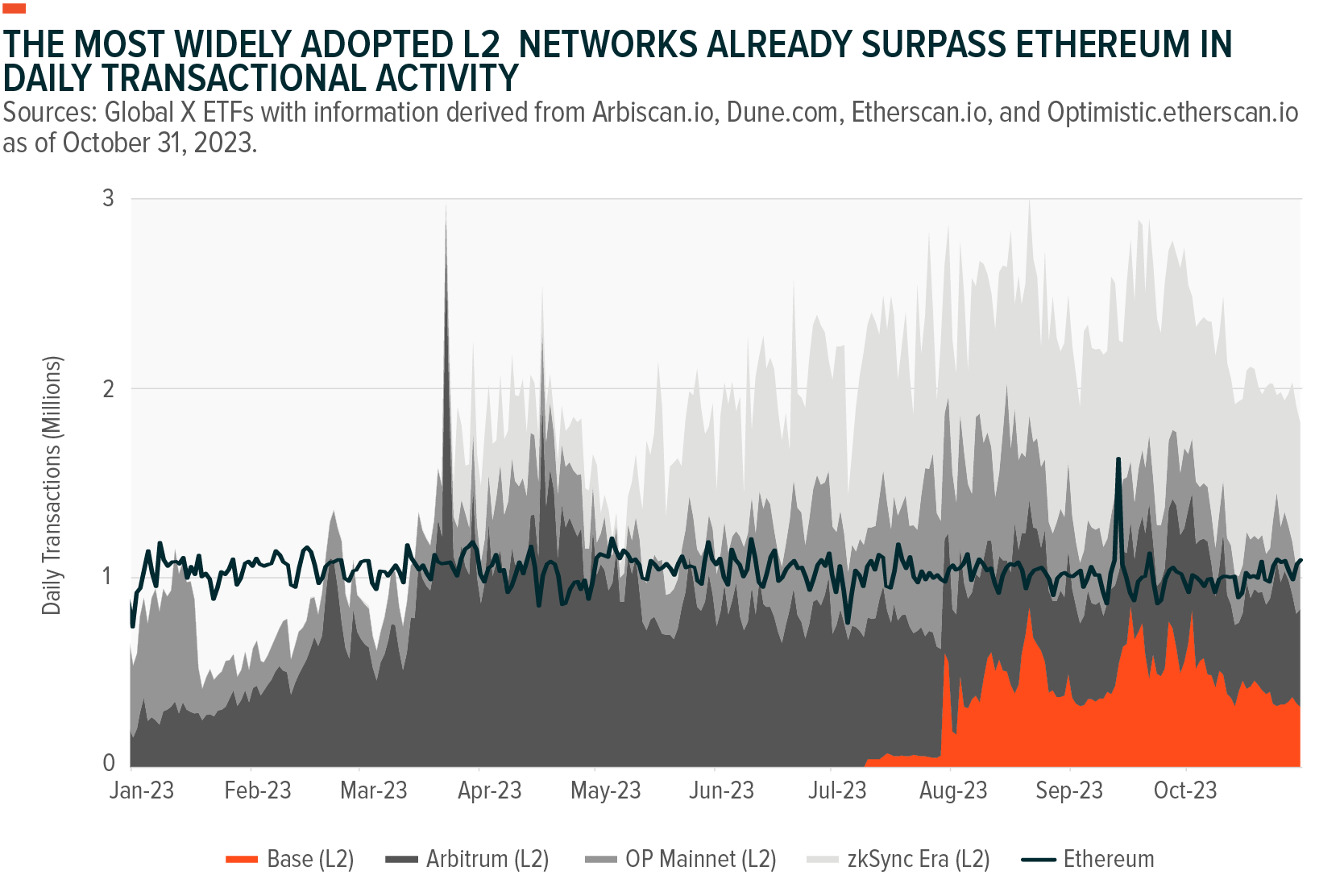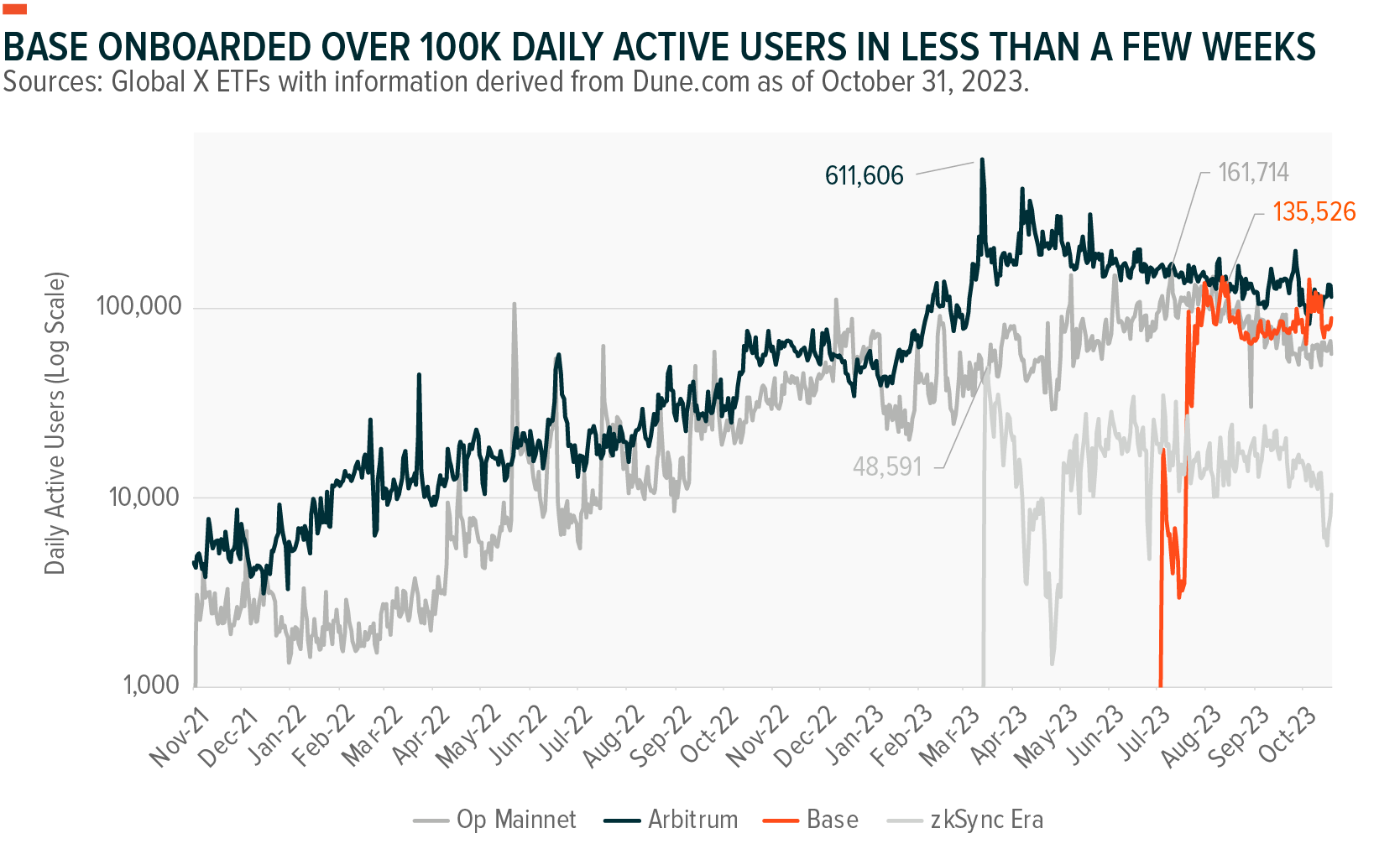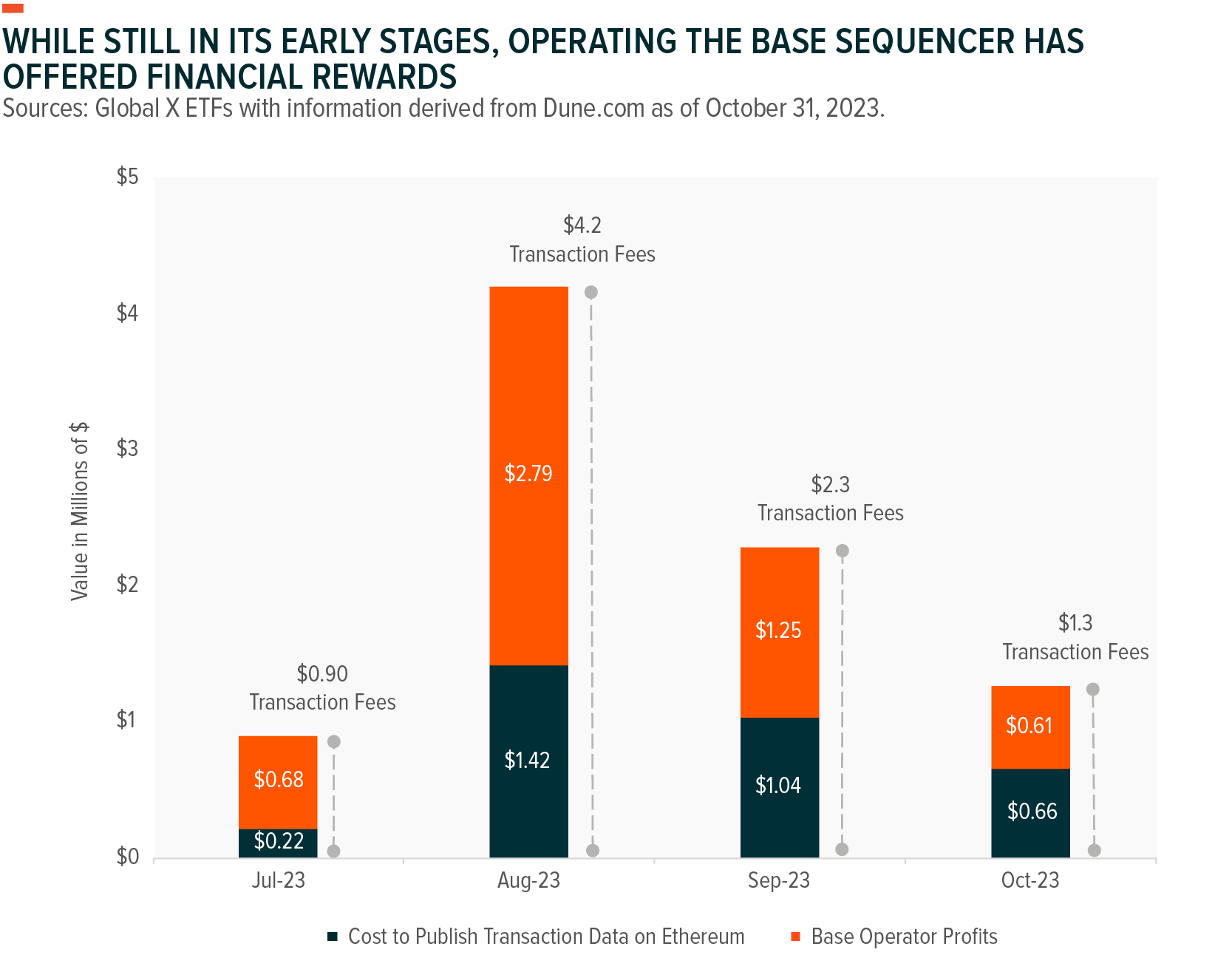While Ethereum is the leading public smart contract blockchain, its widespread popularity, transaction limitations, and variable demand levels can lead to network congestion and increased costs. These high costs often render small transactions impractical and pose obstacles to developing new use cases. For Ethereum to become a globally adopted data settlement platform, there is a growing need for solutions that can enhance transaction speed and reduce costs without compromising the network’s security.
Layer 2 (L2) networks such as Base offer pathways to ease the computational burden on the Ethereum network. Developed by Coinbase, one of the largest offchain cryptoasset exchanges globally, Base is built for speed, affordability, and user-friendliness. In this blog post, we explore the successful early adoption of Base following its launch in July 2023 and how it is contributing to Ethereum’s growth.
Key Takeaways
- Base aims to scale Ethereum by expanding its reach and providing a more efficient, affordable, and user-friendly experience.
- Fueled by Coinbase’s strong brand, L2 technology adoption, and Base’s considerably lower transaction costs compared to Ethereum, adoption has happened quickly as Base has onboarded 100,000 daily active users faster than any other L2 network.1
- Base represents a strong show of commitment to Ethereum by Coinbase and positions the exchange to benefit from the growth of Ethereum’s onchain ecosystem.
Base Unveils New Avenues That Expand the Ethereum Ecosystem
Imagine Ethereum as a bustling boulevard replete with businesses of all types. Potential patrons of these businesses visit the boulevard in their cars but find themselves stuck in traffic due to inadequate infrastructure to handle the influx of vehicles. Meanwhile, a new train system running parallel to, but seamlessly integrated with the main boulevard makes its debut, providing a swift and cost-effective means of transport for these travelers, and a means of alleviating some of the road traffic.
Now, instead of travelers sitting in traffic and paying high tolls, the train works to spread the cost out among a larger group of people, with individuals paying only a minimal fee for the convenience of boarding and disembarking at a station of their choice. This system not only alleviates traffic congestion but also enhances affordability, thereby improving the overall ecosystem’s efficiency and expanding the available navigation space.
Just like trains help to alleviate traffic on the boulevard, L2s play a crucial role in alleviating network congestion on Ethereum. They work by shifting the execution of transactions away from the Ethereum chain and onto adjacent networks. Periodically, they consolidate these transactions into a single cryptographic proof and post the proof to Ethereum as a single transaction. This innovative approach not only ensures that activity on L2 networks inherit the security assurances of Ethereum, but also expands the Ethereum ecosystem’s transactional throughput while reducing average user costs.
In this context, Base is one of a growing number of L2 networks that extends the surface area of Ethereum and embraces ether (ETH) as the denominating currency within the ecosystem. What sets Base apart is its unique position as the first L2 network supported by a well-established public company committed to advancing crypto adoption.
Coinbase unlocks access to a vast user base and over $130 billion in assets on its exchange platform.2 Furthermore, it offers a comprehensive suite of tools and infrastructure for developers to harness. For example, application developers have access to a range of integrations, including fiat onramps, a bridge to its widely adopted mobile app, and a user-friendly self-custodial wallet. Similarly, for users, Base is expected to simplify the blockchain experience as Coinbase streamlines interactions with these applications through direct in-app integrations.
Base Gains Strong Momentum as Transactions Migrate from Ethereum to L2 Networks
Early indications are that L2 networks like Base have found strong product-market fit. The clearest evidence of this is that over 2 million daily transactions are now facilitated by L2 networks. Much of this migration can be attributed to the much lower costs of using L2s. Base, for example, charges an average transaction fee of $0.31 for a ~$200 USDC stablecoin transfer, a ~94% reduction over Ethereum’s current fee of $5.02.3,4

Further, in just three months as a live network, Base has grown its user base to more than 2.5 million addresses.5 Undoubtedly, Base’s rapid growth has been driven by increasing awareness of and familiarity with L2 networks over the past two years, as well as by the significant technological advancements that have been made within scaling technology during this time. Coinbase has also made the marketing of Base a strategic priority.
As the ecosystem of available applications on Base expands and the user experience continues to improve, we expect Base’s active user base to continue to grow.

At present, more than $565 million has been transferred onto Base by its active user base, making it the third-largest L2 network behind only Arbitrum and Optimism which have $6.5 billion and $3 billion in assets deposited on their network.6 The majority of this value periodically engages with a diverse range of applications, mostly consisting of onchain financial services and novel social platforms.
Base Solidifies Coinbase’s Commitment to Ethereum and Paves the Way for New Business Horizons
Base symbolizes Coinbase’s vote of confidence in Ethereum and a commitment to expand the network. Coinbase is well-positioned to make Ethereum more accessible, reducing the barriers for users to engage with the sea of available applications and providing developers with the tools to contribute to the ecosystem’s growth more easily and effectively.
This commitment not only strengthens Ethereum’s ecosystem but strategically positions Coinbase to explore novel business opportunities. As Base is used, cryptographic proofs summarizing network activity must be submitted and settled on the Ethereum network. Coinbase currently manages the data relay process, referred to as the sequencer, and can capitalize both by ordering transactions as well as on the margin between fees charged for offchain transaction execution and the costs associated with settling batches of transactions on Ethereum.
To date, Base has generated approximately $5.3 million in profit through these operations.7 As user activity on Base continues to grow, we expect the profits earned from these activities to grow in kind. Eventually, the task of operating the L2 sequencer and relaying transactions back to Ethereum is poised to become a collaborative effort involving multiple parties, thus, an eventual distribution of these profits beyond Coinbase is anticipated.

Operating Base presents a fresh opportunity for Coinbase, but there may be additional avenues to explore. By having access to a user’s first touch point into Base via its mobile app and wallet infrastructure, Coinbase can strategically implement design choices and processes to extract fees and generate value. For example, this could involve earning fees by providing a fiat onramp for applications deployed on Base and implementing backend fees for streamlining user experience processes that simplify user interactions with these applications. Looking ahead, Coinbase may even explore the development of its own fee-generating applications, further contributing to the growing ecosystem of the Ethereum network.
Conclusion: Base Is an Acknowledgment of Ethereum’s Vision and We Believe a Key Player in Advancing Crypto Adoption
Ethereum needs alternative pathways to improve network efficiency and affordability, and Base is a prime example of such an alternative. Marking a significant milestone in the maturation of Ethereum, Base embodies the ongoing progress in open-source L2 software while benefiting from Coinbase’s expertise and large user base. By positioning itself as an accessible gateway to the Ethereum ecosystem, Base is expected to provide users with a streamlined and user-friendly experience, making the Ethereum ecosystem more approachable for the masses.
The launch of Base also highlights how companies like Coinbase can contribute to Ethereum’s scalability and unlock new business opportunities. With Base, Ethereum takes a step closer to becoming an integral part of our digital lives, while Coinbase solidifies its trailblazing role in the industry.
Related ETFs
Click the fund name above to view current holdings. Holdings are subject to change. Current and future holdings are subject to risk.
 Global X Research Team
Global X Research Team